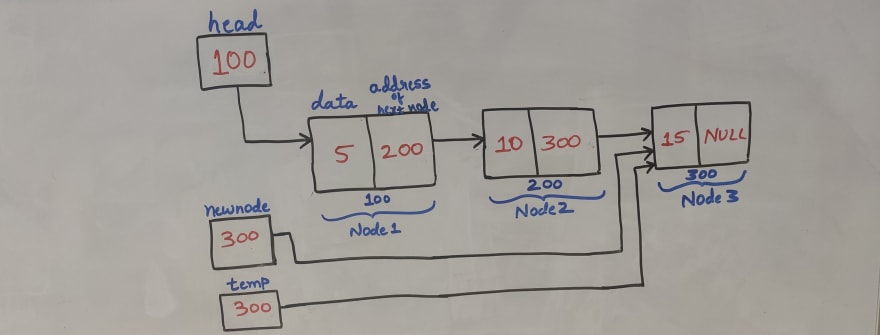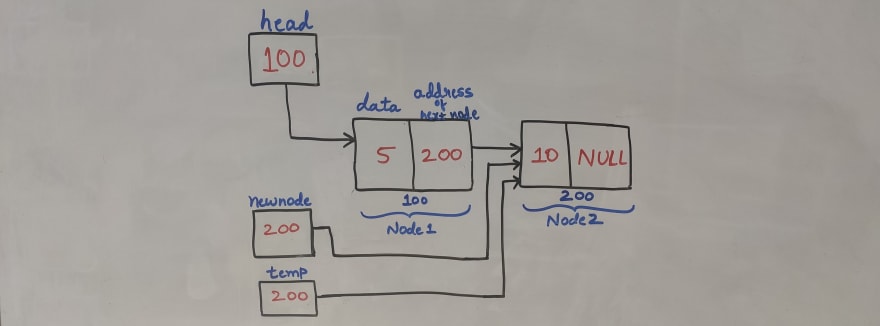In a linked list, a block of memory allocated for an element is referred to as a node. Each node contains two types of information,
- Data
- Pointer to the next node (address of the next node).
The pointer of the last node in the linked list is always equal to NULL.
The below figure is the logical representation of the linked list

Note : (5, 10, 15 and 20 are assumed data) and (100, 200, 300 and 400 are addresses of memory locations)
(https://www.coderlogs.com/post/6257cf1a752339739aa908d4/-Memory-Usage-in-Linked-List-)
Now, let us map this logical representation of linked list into C code.
Step 1 : Creating Linked List.
- For the creation of a node, first you need to declare the data and the address part of a node . These two are declared using a user-defined data type
structure.
struct node
{
int data;
struct node *next;
};
As creating a node, the name of the structure
structis assumed asnode.Type of node is
struct node.Type of data is assumed as integer(
int) type.Type of pointer
nextis the type of node as it is going to point to the immediate next node in the list.Before a node creation, one pointer is initialized to
NULLwhich is called as aheadpointer.After the creation of a node, this
headpointer is made to point to the first node in the list .After declaration of a node members, now create a node by using dynamic memory allocation function
malloc.
newnode = (struct node *)malloc(sizeof(struct node));
- The structure member
datais of typeintso 4-bytes for data and another member is pointernextso 4-bytes (for 32-bit machine) fornexthence total8-bytes(which is called as a node) is assigned by themalloc. And the address of the first location is stored into another pointer namednewnodeof typestruct node.
Note : Assuming address of first location of 8-byte as 100.
The pointer
newnodenow points to the first node because it contains address of first 8-bytes as shown in the fig below.Now, insert the data (for ex: 5) into the first node by accessing the structure member
datausing the pointernewnodeand initialize the memberaddresstoNULLas it is the first node.
printf("Enter the data%d : ", i);
scanf("%d", &newnode->data);
newnode->next = 0;
- Now link the pointer
headto the node1 by copying the address ofnewnodeintoheadpointer.
if(head == 0)
{
head = temp = newnode;
}
- Hence, a first node is created in the list.
- If you want to create more than one node in the list then, before the creation of first node write the number of nodes
nrequired (for example : n = 4 ) and declare one temporary pointertempof typestruct node.
printf("Enter the number of nodes in the list : ");
scanf("%d", &n);
- Using for loop, for
i=1, first node is created where pointersnewnodeandheadare linking to the first node and maketempto link it to the first node by copying the value ofheadpointer into it.
- for
i=2, malloc assigns another8-bytesof locations whose starting address is stored into pointernewnode. Now enter data (for ex: 10) into that node2 by accessing structure memberdatausing pointernewnodeand initialize the address part of node2 toNULL. To create a link from node1 to node2 update theaddresspart of node1 to whichtempis pointing by the value ofnewnodeand maketempto point to node2 by copyingnewnodetotemp.
Positions of pointers after the creation of node2 :
- pointer
headis pointing to node1. - pointer
tempis pointing to node2. - pointer
newnodeis pointing to node2.
Note : Assuming address of second node's first location as 200.
if(head == 0)
{
head = temp = newnode;
}
else
{
temp->next = newnode;
temp = newnode;
}
- for
i=3, malloc assigns another8-bytesof locations whose starting address is stored into pointernewnode. Now enter data (for ex: 15) into that node3 by accessing structure memberdatausing pointernewnodeand initiaize the address part of node3 toNULL. To create a link from node2 to node3 update theaddresspart of node2 to whichtempis pointing by the value ofnewnodeand maketempto point to node3 by copyingnewnodetotemp
Positions of pointers after the creation of node2 :
- pointer
headis pointing to node1. - pointer
tempis pointing to node3. - pointer
newnodeis pointing to node3.
Note : Assuming address of third node's first location as 300.

- for i=4, node4 will be created and the positions of pointers :
- pointer
headis pointing to node1. - pointer
tempis pointing to node4. - pointer
newnodeis pointing to node4.
Note : Assuming address of fourth node's first location as 400.
This way a Linked List of 4 nodes is created.
Step 2 : Displaying Linked List.
- To display the created linked list, first make
tempto point node1 by copyingheadtotemp.
temp=head;
- Print the data part of node1 to which
tempis pointing and then update thetempvalue with address part of node1 which makestempto point node2. Now print the data part of node2 and again update thetempvalue with address part of node2 which makestempto point node-3. Likewise keep on printing the data and updatingtempvalue untiltempis not equal toNULL.
Note: Pointer temp becomes NULL when it points the last node in the list.
while(temp!=0)
{
printf("%d ",temp->data);
temp=temp->next;
count++ // counting number of nodes in the list //
}
C-code that demonstrates the creation and display of linked list
#include <stdio.h>
#include<stdlib.h>
int main()
{
struct node
{
int data;
struct node *next;
};
struct node *head = 0, *newnode, *temp;
int count=0, n;
printf("Enter the number of nodes in the list : ");
scanf("%d", &n);
for(int i = 1; i<=n; i++)
{
newnode = (struct node *)malloc(sizeof(struct node));
printf("Enter the data%d : ", i);
scanf("%d", &newnode->data);
newnode->next = 0;
if(head == 0)
{
head = temp = newnode;
}
else
{
temp->next = newnode;
temp = newnode;
}
}
printf("--------------------------------\n");
temp=head;
printf("Linked list : ");
while(temp!=0)
{
printf("%d ",temp->data);
temp=temp->next;
count++; //counting number of nodes in the list//
}
printf("\nCount = %d",count);
}
I own a website www.coderlogs.com where in I write similar blogs so do visit this website for more such blog posts.







Top comments (1)
Thanks for your articles. It's great!. I don't understand that why do you use temp pointer in this case ?